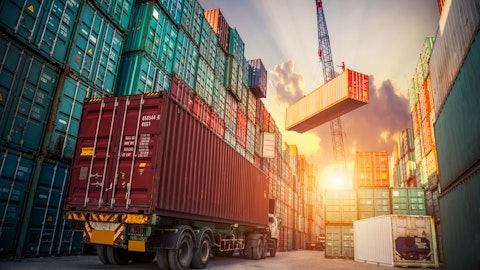So we think that the opportunity for conversion is significant both in the short and longer haul, and we’re very focused on getting that back.
Brian Alexander: Yes, Brian. This is Brian. I’ll just add in that, too. We’ll continue to focus and target the cross border. We’ve started that process already. We have some confirmed wins, and we expect those to expand going into next year. We have a superior product on the rail with our partners there on service and transit, and also diversified offerings as well there, too. So that’s something that we’ll continue to target as we grow into 2024.
Brian Ossenbeck: Okay. And in terms of capacity boxes, as rail service comes back, there’s going to be more boxes effectively out there. What are you doing in terms of your storage? And how do you view CapEx and that investment on the slide deck you’ve got, more color in terms of the longer term viewpoint, but how does that investment translate here to the rest of this year and I guess into next year?
Phil Yeager: Yes, Brian, we have boxes stacked now. I think a lot of the industry does right now. We’ve started to actually unstack a little bit as we’ve started to handle and manage through this muted peak. We’ll evaluate, as we finish out the year, how we manage that as we enter the year. But certainly as that volume returns, we’ll be bringing down that stack we mentioned about our discipline around targeting balance in our network and getting the most utilization out of that equipment. And as that improves, we’ll be able to evaluate what we need as we go into next year. Geoff, maybe you want to talk a little bit about our CapEx plan on that.
Geoff DeMartino: Sure. We’d expect for this year, our guidance is 140 to 150. Our preliminary thoughts for next year would be a pretty big reduction in that. I think on the container side, we probably would be looking to add to the fleet. Next year and then we do have a smaller replacement cycle on the tractor side, so certainly something south of 100 million next year, which would have a pretty big impact on our free cash flow.
Phil Yeager: Well, only other thing that I would highlight is we’ve seen utilization improve about 10% sequentially from Q2 to Q3. So we are getting more out of the existing equipment. We still have a ways to go, but it is good to see progress on that very key metric.
Brian Ossenbeck: All right, thanks. Just one quick follow up on balance sheet and the leverage. I know, Phil, you talked about not being in a hurry to get to that new mark, but maybe you can just give some thoughts in terms of how you and the Board are looking at going through that process and if there’s anything we should sort of pencil in for buybacks here in the near-term.
Phil Yeager: Sure. So we’re going to be very thoughtful around that. As we mentioned, we have some very interesting acquisition opportunities that we’re continuing to look at. I think it’ll take likely two to get us to the middle of the leverage target that we laid out, but we are going to be thoughtful on the approach as we did roll out the new repurchase plan, assuming that we would execute on it, I don’t think there’s anything to build into the model. We certainly did in our forecast, but at the same time, we will be opportunistic with it and utilize the very strong balance sheet that we have effectively. Geoff, you want to add?
Geoff DeMartino: Yes. I think, again, the use of the authorization will be tempered by our outlook for both CapEx and acquisitions.
Brian Ossenbeck: Okay. Makes sense. Thanks, guys.
Operator: Thank you. Our next question is from Bascome Majors of Susquehanna Financial Group. Please proceed with your question.
Bascome Majors: If you look at the guidance and results for 3Q and 4Q, you’re at $1 or so earnings run rate. You typically do less seasonally in the first half than you do in the second half. So barring some superseasonal outcome in the first half of next year, you’ve got a lot of catch up to do in the second half. Can you walk us through what has to happen to deliver the earnings growth that you hope for preliminarily next year from the starting place we are today? And just any other thoughts to help us kind of level set expectations for next year now rather than waiting till February? Thank you.
Phil Yeager: Sure. So I do think we are seeing some peak season we need to perform in the upcoming bids. That is a key priority, I think capacity continuing to exit and the spot market staying relatively balanced. I think the consumer staying resilient. All those pieces are certainly going to support that. We need to successfully onboard a lot of the logistics wins that we have and we need to get our intermodal fleet moving again. Having a significant portion stacked is not optimal for earnings growth. I think if you layer in us then executing on the capital allocation plan and acquisition strategy that should frame up earnings growth. I do agree with you, it will likely be driven by execution in the latter portion of the year. We would hope to see some increase in demand in the spring to help drive that. And we think if we do see that, we’re in an excellent position to go out and execute.
Geoff DeMartino: I’ll just add one item to that too is we’ve created a really long tail of customers that we are cross selling into right now. And as we look at it from a revenue perspective, 80% of our revenue is using two or more services of ours. But as we look at that customer count, 80% of those customer count is only using one Hub service. So that’s a big part of our growth plan is continuing to cross sell that’s been underway and is going to accelerate as we go into next year.
Bascome Majors: Thank you for that. Can you update us on where big compliance is and I apologize if I missed that earlier and just maybe anecdotally how are these conversations going with your customers? It seems that the economic case for intermodal from your earlier discussion is very attractive, but the reality is it’s just not converting. What is holding that back and what has to happen to change that in your view? Thank you.
Brian Alexander: Sure. In regards – this is Brian. In regards to the bid compliance, we started the year at about 70%. We finished last year at 81. We did see that compliance improved throughout the year, finishing out Q3 at around 78% compliance. And we think a lot of that was the shipper starting to realize where their balance was at, where their demand was going to be. A lot of those conversations with them is about the seasonality of their inventory and as that starts to rebuild, they know that over the road capacity is going to be exiting and needs to come back into the rail and they want to have that assurance that the service is going to be there that we’ve talked about. And as Phil mentioned, we’ve seen the continued investments from our rail partners to ensure that that service is going to be there and from a – to be a little bit more tactful in that too.



